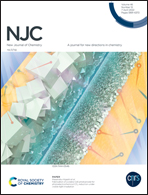Thiolate-assisted copper(i) catalyzed C–S cross coupling of thiols with aryl iodides: scope, kinetics and mechanism†
Abstract
Transition metal catalyzed coupling of thiols with aryl iodide offers a convenient method for accessing C–S linkage in organic synthesis. Herein, we report an efficient and practical method for the C–S cross coupling of thiophenols with aryl iodides using a Cu(I) catalyst. A diverse set of thiophenols is coupled with electron rich and poor aryl iodides to obtain diaryl sulfides in good to excellent yields. Noteworthily, these reactions proceed smoothly in polar protic solvents and under ligand-free environments. This procedure also finds application in the synthesis of 2-aminophenyl sulfide derivatives via ring opening of readily available benzothiazole. Furthermore, we performed kinetics and computational studies to understand the mechanism of the Cu(I) catalyzed reaction in the absence of a ligand. Hammett plots of the reaction rates versus the substituent constant show that these coupling reactions are modestly sensitive to the substituents on thiophenols as well as aryl iodides, indicating the involvement of both the reactants in the rate-determining step of the reaction. On the other hand, computational investigations of the different mechanistic pathways suggest that the strong coordination of thiolate to Cu may generate the catalytically competent intermediate [Cu(SPh)2]K which can initiate the catalytic cycle. The pathway initiated by [Cu(SPh)2]K is predicted to proceed through the lowest energy transition states and intermediates relative to the separated reactants.



 Please wait while we load your content...
Please wait while we load your content...